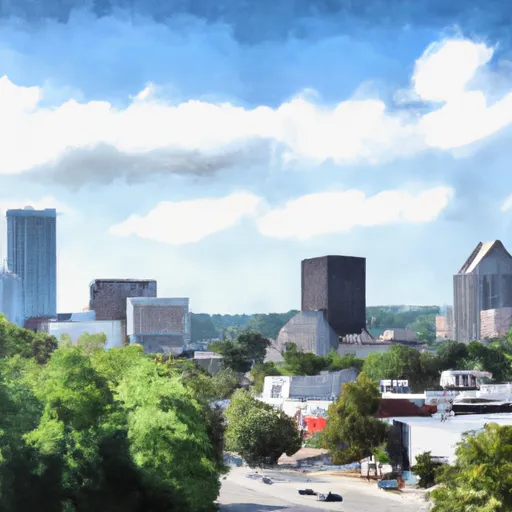-
 Snoflo Premium
Snoflo Premium
Get unlimited access to all our content
With no Ad interruptions! - Start Your Free Trial Login with existing account
Huntsville
Eden Index
Climate
8.2
•
Recreation
2.5
•
Community
0.5
•
Safeguard
4.3/10

Huntsville, Arkansas, located in the scenic Ozark Mountains, offers a pleasant climate with distinct seasons. Summers are warm and humid, with average temperatures ranging from 85°F to 90°F. Winters are mild, with temperatures averaging between 30°F and 50°F. Spring and fall are characterized by moderate temperatures and colorful foliage, attracting nature enthusiasts.
Hydrologically, Huntsville is surrounded by the Kings River, which provides ample opportunities for water-based activities. The river is known for its clear waters, making it ideal for swimming, fishing, and kayaking. Additionally, nearby Beaver Lake offers boating, fishing, and water skiing.
Outdoor enthusiasts will find plenty of recreational opportunities in and around Huntsville. The area is renowned for its rugged landscapes, offering activities such as hiking, mountain biking, and rock climbing. The Ozark Highlands Trail, which stretches over 165 miles, showcases stunning natural beauty and diverse wildlife. With numerous state parks and wilderness areas nearby, camping and wildlife viewing are popular pastimes.
In conclusion, Huntsville, Arkansas, offers a pleasant climate, beautiful hydrological features, and a variety of outdoor recreational opportunities, making it an ideal destination for nature lovers and adventure seekers.
What is the Eden Index?
The Snoflo Eden Index serves as a comprehensive rating system for regions, evaluating their desirability through a holistic assessment of climate health, outdoor recreation opportunities, and natural disaster risk, acknowledging the profound impact of these factors on livability and well-being.
Climate Health Indicator (CHI): 8.2
Huntsville receives approximately
1165mm of rain per year,
with humidity levels near 81%
and air temperatures averaging around
15°C.
Huntsville has a plant hardyness factor of
6, meaning
plants and agriculture in this region thrive during a short period during spring and early summer. Most
plants will die off during the colder winter months.
By considering the ideal temperature range, reliable water supplies, clean air, and stable seasonal rain or snowpacks, the Climate Health Indicator (CHI) underscores the significance of a healthy climate as the foundation for quality living.
A healthy climate is paramount for ensuring a high quality of life and livability in a region, fostering both physical well-being and environmental harmony. This can be characterized by ideal temperatures, reliable access to water supplies, clean air, and consistent seasonal rain or snowpacks.
Weather Forecast
Streamflow Conditions
Upper White
Area Rivers
Upper White
Snowpack Depths
Upper White
Reservoir Storage Capacity
Upper White
Groundwater Levels
Recreational Opportunity Index (ROI): 2.5
The Recreational Opportunity Index (ROI) recognizes the value of outdoor recreational options, such as parks, hiking trails, camping sites, and fishing spots, while acknowledging that climate plays a pivotal role in ensuring the comfort and consistency of these experiences.
Access to outdoor recreational opportunities, encompassing activities such as parks, hiking, camping, and fishing, is crucial for overall well-being, and the climate plays a pivotal role in enabling and enhancing these experiences, ensuring that individuals can engage in nature-based activities comfortably and consistently.
Camping Areas
| Campground | Campsites | Reservations | Toilets | Showers | Elevation |
|---|---|---|---|---|---|
| Highway 157 Primitive | None | 203 ft | |||
| Hervey Access Camping | None | 247 ft | |||
| Nashville City Park | None | 456 ft | |||
| Teague Lake Primitive | None | 199 ft | |||
| Dam Area - Lake Greeson | None | 431 ft | |||
| Fair City RV Park | 100 | 317 ft | |||
| Ivan Lake | 4 | 212 ft | |||
| Parker Creek - Lake Greeson | None | 684 ft | |||
| Allens Ferry at Little River | None | 261 ft | |||
| Crater of Diamonds State Park | None | 339 ft |
Nearby Ski Areas
Catastrophe Safeguard Index (CSI):
The Catastrophe Safeguard Index (CSI) recognizes that natural disaster risk, encompassing floods, fires, hurricanes, and tornadoes, can drastically affect safety and the overall appeal of an area.
The level of natural disaster risk in a region significantly affects safety and the overall livability, with climate change amplifying these risks by potentially increasing the frequency and intensity of events like floods, fires, hurricanes, and tornadoes, thereby posing substantial challenges to community resilience and well-being.
Community Resilience Indicator (CRI): 0.5
The Community Resilience Indicator (CRI) recognizes that education, healthcare, and socioeconomics are crucial to the well-being of a region. The CRI acknowledges the profound impact of these elements on residents' overall quality of life. By evaluating educational resources, healthcare accessibility, and economic inclusivity, the index captures the essential aspects that contribute to a thriving community, fostering resident satisfaction, equity, and social cohesion.

